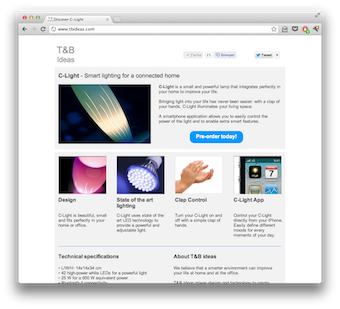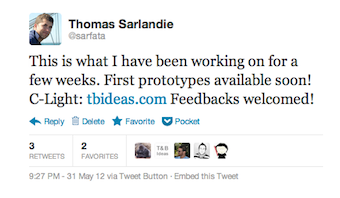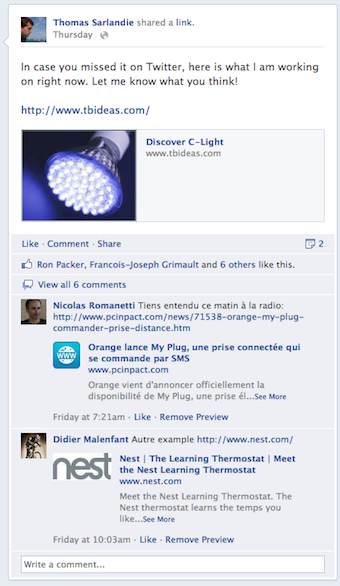Growing ideas
Trees, houses and bushes were passing by as our tuk-tuk pulled by a small motorcycle rushed down the unpaved street of Cambodia. I had only been gone for a few weeks but already my mind was rushing to find a new project to work on. This is when it happened.
How the idea came up is probably not that important. It was probably something that had been running unnoticed in my mind. The peace of the moment gave it an opportunity to materialize in my head. What does matter is: How could I find out whether this was the idea?
One thing I have learnt working with creative people is that a good idea does not just show up. It takes time, it takes energy, you need to work at it. And slowly, as you go, the idea matures, transforms and becomes way more than the initial grain of sand.
What I am really working on is growing ideas. And after having watched the video and read the book, I knew exactly what to do with this idea: Build a Minimum-Viable-Product and get feedback. This is the story of the first iteration on a product called C-Light, a connected lamp, my contribution to the Internet of Things.
First step: a prototype?
I thought about what my lamps should look like, what features they should have, how big they would be, how much I could charge for them. I did some drawings, looked at different light technologies and started to gather the pieces to build a prototype: this is I guess what any engineer would have done and it’s great fun!
Let’s suppose that technical problems always have solutions and that after a few months of hard work, unsuspected problems and lots of money spent on different prototypes, I have a great product that is finally perfect. What would I do next? Build a website, present the product and try to sell it online.
My website online, I might spend weeks trying to get people to visit it and slowly realize that nobody wants my product. It might be too expensive, too complicated or just useless. There must be a better way to do things. The lean startup movement teaches us that the first thing to do is the simplest thing that will bring feedback. And most of the time, the product itself is not the place to start.
The minimum-viable-product for a hardware product is not the product itself, it’s the website that introduces the product. The product does not have to exist, you just need to see how people react to its description. If no-one wants to buy it then it does not matter that the product does not exist, and if they are actually interested, they can probably wait a few weeks.
Building a website

We used the same techniques that I had used for my own website and put a webpage up on which we described the product. To do that, we had to give it a name, choose the most important features, get rid of the others and do some copywriting to build the content.
In order to measure interest we added a Pre-Order button and a link to a Mailchimp form to subscribe to a mailing list. A few lines of Google Analytics JavaScript would let us know how many people came and where they came from.
Online marketing
The final step was to bring visitors to our website. Google AdWords, Twitter and Facebook are all easy solutions when you want to build an audience. We used those three medias over the course of a few weeks and then gathered results.
Adwords

We put up a few ad groups with about 50 keywords and set a budget of $10/day. Our initial cost per click was around $2 but it quickly dropped below $1. This brought a dozen visitors every day with the most successful keywords being things like “dinner light”, “clap lamps” or “wifi lamp”. Our most succesful ad is “Romantic dinner light” with a click-through rate of 0.36% which still seems pretty low to us. Edit: Experienced adwords user, tell us that we should aim for 0.8%.
Overall, not one of the 145 visitors brought to the site through adwords decided to fill-in his email address to receive more information about the product. So far the experiment cost $124. Not a big success!

A few days into the adwords campaign, we decided to let my twitter followers know about what we were working on and I tweeted:
This is what I have been working on for a few weeks. First prototypes available soon! C-Light: http://www.tbideas.com Feedbacks welcomed!
Compared to adwords, the feedback was amazing. In a few hours, I got about a dozen people retweeting, replying or favoriting this tweet. According to Google Analytics, Twitter brought 28 visitors on the page. Not bad with my 288 followers! “This is nice”, we thought but our metric was: how many people will actually give their email address? Only one did.
At this point, we started re-thinking the webpage: it was probably too complicated for people to subscribe. We should have measured more precisely the different steps of subscription, but we had one last experiment to run before making changes.

I simply posted an update on my wall, saying:
In case you missed it on Twitter, here is what I am working on right now. Let me know what you think! http://www.tbideas.com/
Just like it did with Twitter, the feedback came right away: 8 likes, 6 replies. The traffic increase on the website was also significant. With only one facebook post, we received 62 visits on the site. Quite good for my facebook account and my 293 friends. But there again, only one subscription to our mailing list.
Conclusion
This was the first step of an experiment. An experiment to understand whether people would be ready or not to buy a “smart lamp”, but also an experiment to understand how to bring people to a product website and understand their behaviour.
This has taught us a few things:
- Throwing money on google analytics is not the best way to bring traffic to your website. It’s expensive and the traffic is not that well qualified.
- It is extremely important to precisely measure what people do on your website and where they come from. We missed some important metrics (like how many people just clicked on pre-order) and of course there is no way to make up that data once it’s gone…
- Social networks are an extremely efficient way to bring people to your website. Take care of your “friends” because if you want to run experiments like we did, they will be a very precious assets!
So far, the experiment has not really helped to grow the idea. The feedback was too limited and not qualitative. But the lessons learnt are very important and will help us make sure that as the idea matures thanks to prototyping, the website is ready to present it and then gather feedback.
comments powered by Disqus